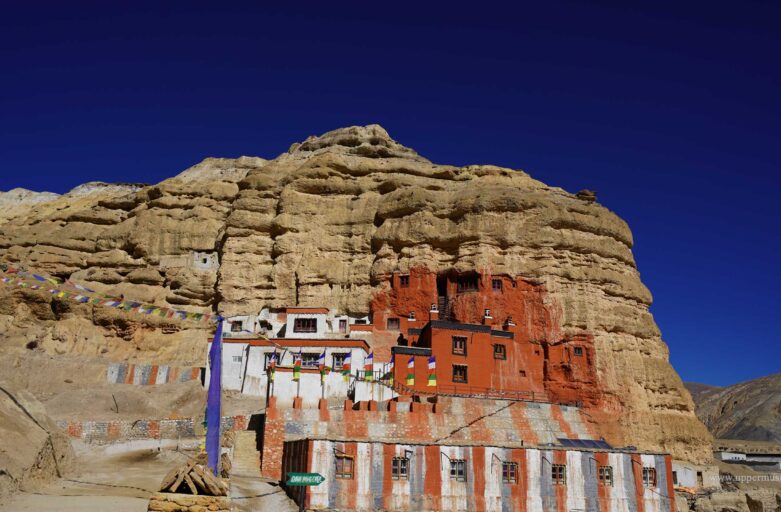Ancient Monasteries of Upper Mustang, Lo Manthang
The monasteries of Upper Mustang are not just architectural marvels; they are living embodiments of a rich cultural and spiritual legacy. Monastery of Mustang are renowned for its intricate frescos, ancient scriptures, statues of deities, great architecture, history and cultural insight etc. Most of the monasteries of upper mustang are almost empty, occasionally monks visit to organize special pray and offerings.
Monasteries in Upper Mustang are the home of monks who dedicate their lives to studying and preserving the teachings of Buddha. These monasteries serve as places of learning, meditation, and community gatherings, festival celebration etc. Monks and lamas residing in these monasteries play a crucial role in preserving and passing down Buddhist teachings and practices.
History and Spirituality
Most of the monasteries of Mustang belong to the Sakya sect of Buddhism. The monasteries of Upper Mustang are the testament of Tibetan Buddhism and it’s enduring influence in this region. Many of these sacred sites date back to the 8th to 15th centuries and preserve the unique cultural identity. The monasteries here are not just places of worship; they are living repositories of Tibetan Buddhist traditions, art, and architecture, preserving a way of life that has endured for centuries.
List of Notable Monasteries of Upper Mustang
01: Kag Chode Thupten Samphel Ling Monastery, Kagbeni (15th century)
Kag Chode monastery is an active center for Buddhist study and practice, with monks residing there and performing daily teaching, rituals, prayers, and ceremonies. It was established in the 15th century. It is associated with the Sakya school of Tibetan Buddhism.
02: Chhusang Monastery
Chhusang gumba is one of the oldest and most important monasteries in the Mustang region, serving as a center for religious learning, meditation, and community gatherings. It is built in traditional Tibetan style, with thick stone walls, wooden beams, and intricate carvings.
03: Samar Monastery in Samar village
The monastery is a key spiritual and cultural center for the local community and reflects the rich Tibetan Buddhist heritage of the region.
04: Chungsi Cave Monastery (Guru Ringpoche meditated in this cave in around 8th century)
05: Thrangu Tashi Choling Monastery (GUMBA) Ghiling (14th to 15th century)
Ghiling monastery serves as an important religious and cultural center, preserving ancient Buddhist traditions and teachings. Serves as a spiritual hub for local Mustangi people and Tibetan refugees.
06: Shedrub Dhargey Ling Monastery, Lo Ghami (14th century)
07: Tsarang Monastery (Red Gompa) (13th century)
Tsarang Monastery established in 13th century and built in traditional Tibetan style, with red color walls, wooden beams, and intricate carvings. It features a large prayer hall adorned with thangkas (Buddhist paintings), murals, and statues of Buddhist deities, including Sakyamuni Buddha, Avalokiteshvara, and Padmasambhava.
08: Lo Gekar Monastery “Ghar Gumba”, (8th century)
09: Thubchen Gompa, Lo-Manthang the capital of mustang (late 15th century)
Thubchen Gompa is known for its large assembly hall, which features impressive murals and statues. The architecture reflects the traditional Tibetan style with thick walls and intricate woodwork. The murals inside Gompa are particularly noteworthy, depicting various deities, mandalas, and scenes from the life of the Buddha.
10: Jampa Lhakang Monastery (early 14th century)
Jampa Lhakhang is the monastery of Maitreya Buddha (Future Buddha). It is three stories adorned with impressive mandala, frescos into the wall and impressive wood carving. The temple is characterized by its tall, imposing structure and traditional Tibetan design. It houses a large statue of Maitreya, which is a focal point for worship and rituals.
11: Monchoe Dragkar Thegchen Ling Gonpa “Chode Gompa” in Lo-Manthang (13th century)
Chode gompa is a monastic school where monks study and practice Tibetan Buddhism. Monks engage in daily rituals, meditation, and the study of Buddhist scriptures. The monastic complex includes several buildings, including main gompa, living quarters for monks, school and museum to see the religious artifacts. Courtyard of Chode monastery and Royal palace are the site of annual Tiji Festivals, a three-day event that celebrates the victory of good over evil. The festival features masked dances, rituals, and ceremonies performed by the monks.
12: Garghu Dhejing Chhyoling Gompa, (Garphu monastery) Chhoser (15th century)
13: Nyiphuk Namdol Norbuling Gompa, (Niphu monastery) Choser (14th century)
14: Chhujung Gompa nearby Dhigaon
15: Samduling Gompa, near Lo-manthang
16: Thukten Dharkelin Gompa “Namgyal Monastery” Near Lo Manthang (10th century)
17: Luri Gompa “Luri cave Monastery” (13th/14th century)
Conservation and Challenges
These Monasteries of Upper Mustang are not only places of worship but also repositories of art, history, and culture. They offer a glimpse into the rich spiritual heritage of the Mustang region and continue to be vital centers for the preservation of Tibetan Buddhist traditions. Most of the monasteries are facing challenges like natural wear and tear, climate change, modernization and absence of monks. Many structures require urgent restoration due to aging and environmental factors. Several organizations and local communities are working tirelessly to preserve these sacred sites but not enough.
Monastery in Upper Mustang are carry historical significance, architectural grandeur, artistic majesty and spiritual impression. The intricate murals, sculptures, and thangkas found in these monasteries are priceless cultural treasures. Embark on a Spiritual Journey to explore the heritage of Mustang Nepal.

